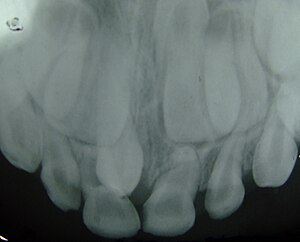Supernumerary tooth
| Hyperdontia | |
|---|---|

| |
| Supernumerary teeth in the premaxillary area | |
| Classification and external resources | |
| ICD-10 | K00.1 |
| ICD-9-CM | 520.1 |
| MeSH | D014096 |
Hyperdontia is the condition of having supernumerary teeth, or teeth that appear in addition to the regular number of teeth. They can appear in any area of the dental arch and can affect any dental organ. The opposite of this condition is hypodontia, where there is a congenital lack of teeth. This is seen more commonly than hyperdontia. The scientific definition of hyperdontia is "any tooth or odontogenic structure that is formed from tooth germ in excess of usual number for any given region of the dental arch” They can be a lot of teeth or not many teeth and can occur on any place in the dental arch. They may be symmetrical or non-symmetrical.
Supernumerary teeth can be classified by shape and by position. The shapes include the following:
When classified by position, a supernumerary tooth may be referred to as a mesiodens, a paramolar, or a distomolar. Occasionally, these teeth do not erupt into the oral cavity but manifest as a malocclusion.
The most common supernumerary tooth is a mesiodens, which is a malformed, peg-like tooth that occurs between the maxillary central incisors.
Fourth and fifth molars that form behind the third molars are another kind of supernumerary teeth.
It is evident that hyperdontia Is more common in the permanent dentition than in the primary. The difference between the prevalence of these teeth in permanent dentition in males and females is considerate. Males show hyperdontia twice as often as females. This approximation does vary in terms of location, any other associating syndromes and ethnicity of the individual. In terms of ethnicity it can be seen that hyperdontia is in fact less common in Caucasian than in Asian populations. There is evidence to show that an individual is more likely to have hyperdontia if people in their family also have hypodontia
Supernumerary teeth may be detected by taking two different x-rays at different angles. Examples of this may be an intra-oral X-ray (one that is taken inside the mouth) and a panoramic radiograph. However, these x-rays are 2D and therefore do not accurately portray the 3D view of the teeth.
There is evidence of hereditary factors along with some evidence of environmental factors leading to this condition. While a single excess tooth is relatively common, multiple hyperdontia is rare in people with no other associated diseases or syndromes. Many supernumerary teeth never erupt, but they may delay eruption of nearby teeth or cause other dental or orthodontic problems.Molar-type extra teeth are the rarest form. Dental X-rays are often used to diagnose hyperdontia.
...
Wikipedia
